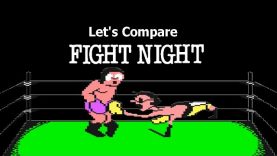Let’s Compare ( Primal Rage )
Gaming History Source
Video Locations:
1. Arcade 0:41
2. Gameboy 2:59
3. Game Gear 5:18
4. Amiga 8:16
5. Genesis / Mega Drive 10:45
6. Sega 32X 13:13
7. Super Nintendo 15:32
8. DOS 17:52
9. 3DO ( SOUND ISSUES ) 20:31
10. Jaguar CD 22:50
11. Playstation 25:48
12. Saturn 28:08
13. X-BOX, PlayStation 2,
Game Cube, Windows as part
of Midway Arcade Treasures 2 30:27
Description Source:
http://en.wikipedia.org/wiki/Primal_Rage
Primal Rage is a versus fighting game developed and released by Atari Games to arcades in 1994. The game takes place in a post-apocalyptic version of Earth called “Urth.” Players control one of seven large beasts that battle each other to determine the fate of the planet. Matches feature many of the conventions of fighting games from the era, including special moves and gory finishing maneuvers.
Various ports were released for home consoles and personal computers. Efforts to perfectly emulate the arcade original have as yet been unsuccessful, due to an unusual copy protection method developers used.
Toys, comics, a novel (Primal Rage: The Avatars by John Vornholt) and other merchandise tie-ins were also produced. A sequel to the game, Primal Rage II, was close to completion, but never released.
Gameplay:
Primal Rage is a traditional two-dimensional fighting game in which two players select characters to battle each other in one-on-one combat, or a single player finishes a campaign of fights against the CPU, over increasing difficulty. The final battle of the single-player game consisted of fighting all the other CPU monsters with an increased power bar, made available in a mini-game prior to the fight. A total of seven characters are available for players to select from (as listed below). Each character has his or her own specialized set of three attack moves and abilities. In the game, the object is to deplete the opposing character’s health meter as fast as possible. If “Game Gore” (an option on some consoles) is switched on, then a defeated character’s heart will explode into a bloody mess, and their brain will dissolve to ashes.
While fighting, human tribesmen will wander nearby and worship their gods during battle. This allows for the creatures to toss them around or devour some to regain strength (eating opponents’ worshipers will add a bonus to one’s score, while eating one’s own will penalize the player). Prior to the final battle, a mini game commences in which one is required to eat as many worshipers as possible to increase health for the endurance round. Two human-controlled characters can trigger an easter egg of human volleyball, by keeping worshipers off the ground and batting them back and forth.
Unlike most fighting games, where the special moves are performed by moving the joystick followed by pressing one or more buttons, Primal Rage features a system where the player holds down certain buttons, then performs the joystick movements. Later revisions of the arcade game added the ability to perform “special moves” in the more traditional way, with motion followed by button presses, but kept the original method as well. After the opponent is defeated, a brief moment is allowed for the player to perform a fatality that finishes the adversary in a more dramatic fashion; these were performed in a similar manner to the special moves. Although all characters feature three finishing moves, some of them were more easter eggs than fatalities, such as Vertigo’s “La Vache Qui Rit” (French for “the laughing cow”), a fatality in which Vertigo transforms her opponent into a cow, which moos and runs away.
If you would like to support Gaming History Source. You can do so by making donations at. http://www.patreon.com/ghs













